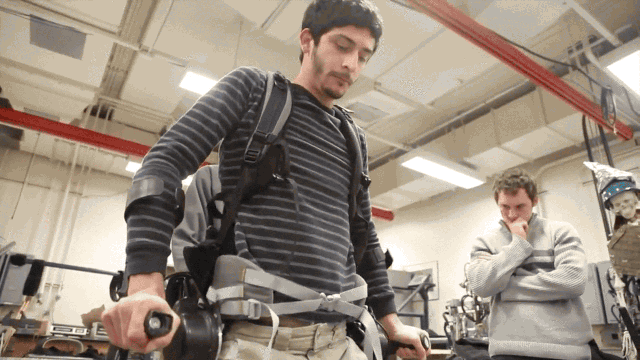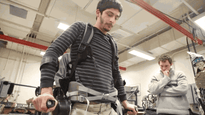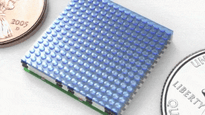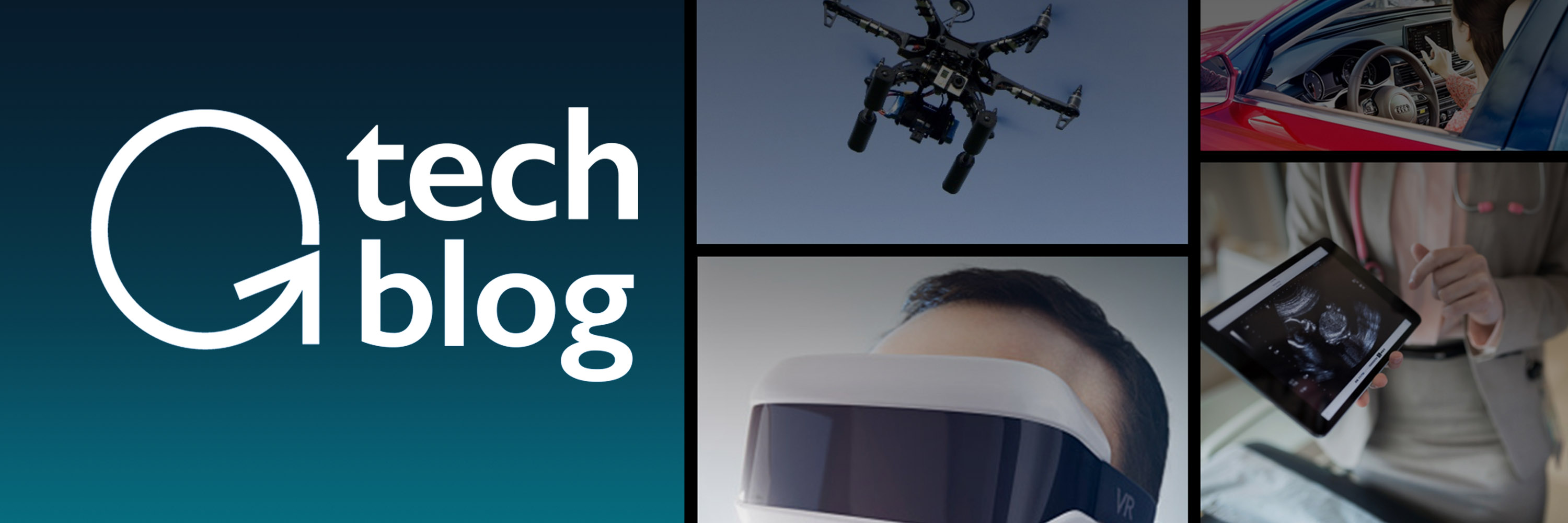
In this week's Abundance Insider: Concussion-fighting collars, robot golfers and shape-shifting exoskeletons.
Cheers,
Peter, Marissa, Cody, Maxx, Kelley and Greg
P.S. Send any tips to data@diamandis.com, and send your friends and family to this link to subscribe to Abundance Insider.
Modular Exoskeleton Shape-Shifts to Accommodate Multiple Disabilities

What it is: SuitX is a California robotics startup that hopes to make wheelchairs obsolete. Weighing in at 27 pounds, the modular Phoenix exoskeleton can be rearranged to suit a wide range of people and disabilities. The best news is that it costs $40,000 -- princely, but still cheaper than other exoskeletons, which cost between $70,000 and $100,000.
Why it's important: Exoskeletons have tremendous implications for those whose jobs require intense manual labor, the elderly and infirm, and people with disabilities and mobility issues. These bionic suits are still pricey now, but the emergence of companies like SuitX proves that the technology is beginning to demonetize.
Spotted by Marissa Brassfield
Robot Golfer Sinks Hole-In-One

What it is: Nearly 20 years after Eldrick "Tiger" Woods aced the 163-yard 16th hole at TPC Scottsdale, a robot named LDRIC repeated the feat in just five swings. The Golf Laboratories robot was designed to test golf clubs, and can be programmed to mimic any player's swing characteristics and play shots with minute adjustments. You'll have to watch the video to see how the crowd reacted.
Why it's important: When robots can play games as well as humans, we enable a new paradigm of entertainment. Imagine playing a round of golf with your friends and a robot coach, or watching an all-robot golf tournament.
Spotted by Greg O'Brien
Machine-Learning Technique Uncovers Unknown Features of Pathogens

What it is: Joint research from the University of Pennsylvania and Dartmouth has led to a new machine learning technique called ADAGE (Analysis using Denoising Autencoders of Gene Expression) to uncover previously unknown features of organisms -- including pathogens that are resistant to multiple drugs. "For example, the technique learned to identify the characteristic gene-expression patterns that appear when a bacterium is exposed in different conditions, such as low oxygen and the presence of antibiotics," reports KurzweilAI.
Why it's important: Evidence that scientific advancements are keeping up with the rise of so-called "superbugs." ADAGE can help microbiologists identify previously unknown biological patterns and characteristics, either complementing or refuting their own knowledge.
Spotted by Peter Diamandis
New Collar Promises to Keep Athletes' Brains from "Sloshing" During Impact

What it is: Gregory Myer, director of the Cincinnati Children's Hospital's human performance laboratory, is testing a collar that could prevent traumatic brain injuries in soldiers and athletes. Q30 Innovations designed the collar after studying woodpeckers and bighorn sheep -- two animals that can withstand repetitive blows to the head without their brains sloshing -- to see how their bodies prevent their brains from sloshing around.
Why it's important: Brain injuries are still something of a mystery, but research like this generates valuable data. Wearable technologies like this collar could inform the design of next-gen protective gear for soldiers and athletes at every level of sport.
Spotted by Marissa Brassfield
Soft Robotic Gripper Handles Objects of Any Shape

What it is: EPFL scientists have developed a robot with a "soft gripper" that uses electroadhesion to handle objects of nearly any shape -- from eggs to water balloons and a sheet of paper.
Why it's important: EPFL says that this is the first time electroadhesion has been combined with soft robotics to grasp objects. The gripper enables robots to handle food or capture debris (including in space), and also enables more powerful prosthetic limbs (thanks to artificial muscles).
Spotted by Marissa Brassfield
Elon Musk: SpaceX Wants to Send People to Mars by 2025

What it is: Earlier this week, during a Hong Kong forum, SpaceX CEO Elon Musk announced the company's latest moonshot: to send people to Mars by "around 2025." Added Musk, "It's the only planet we really have a shot at establishing a self-sustaining city on."
Why it's important: Musk explains the implications of SpaceX heading to Mars in under a decade: "It's really a fundamental decision we need to make as a civilization. What kind of future do we want? Do we want a future where we're forever confined to one planet until some eventual extinction event however far in the future that might occur? Or do we want to become a multi-planet species?"
Spotted by Peter Diamandis
Google Plans to Beam 5G Internet From Solar Drones

What it is: The same Google team behind Project Loon has a new idea to deliver Internet to the world, and it involves solar-powered drones. Project Skybender uses millimeter wave-based Internet -- which reportedly has data transmission speeds 40 times faster than LTE.
Why it's important: Current cellphone spectrums are packed, and millimeter wave-based data transfer enables us to use an entirely distinct spectrum. Between Project Loon and Project Skybender, Google's cemented its intent to demonetize and democratize Internet access.
Spotted by Marissa Brassfield
Lockheed Martin's SPIDER Enables Smaller, Supercharged Telescopes

What it is: Lockheed Martin has just unveiled SPIDER (Segmented Planar Imaging Detector for Electro-optical Reconnaissance), a telescope technology that relies on silicon-chip photonic integrated circuits (PICs). Instead of bulky mirror-based optics, SPIDER uses thousands of tiny lenses connected to laser-printed PICs.
Why it's important: Digital Trends reports that SPIDER offers up to 99% savings in weight and size when compared to traditional microscopes. It has tremendous applications for space, auto safety sensors, military reconnaissance, and targeting instrumentation for vehicles, vessels and aircraft.
Spotted by Marissa Brassfield
Scientists Decode Brain Signals for Real-Time Image Recognition

What it is: For the first time ever, University of Washington scientists have decoded brain signals in real time. The technique takes us one step closer to brain mapping, as it helps researchers pinpoint which brain locations are sensitive to certain information types. "The computational tools that we developed can be applied to studies of motor function, studies of epilepsy, studies of memory," explained Jeffrey Ojeman. "The math behind it, as applied to the biological, is fundamental to learning."
Why it's important: In addition to real-time brain mapping, KurzweilAI points out that this development may help "locked-in" patients (paralyzed or had a stroke) communicate.
Spotted by Peter Diamandis
Artificial Intelligence Exec to Lead Google Search Team

What it is: Amit Singhal, who has led the technical development of Google's search engine since 2000, has retired. His successor will be John Giannandrea, an artificial intelligence expert and Google exec who's been with the firm since 2010, when Google purchased Giannandrea's company Metaweb Technologies and incorporated its assets into Google's knowledge graph.
Why it's important: Giannandrea's appointment to the search team backs up this statement by Google CEO Sundar Pichai on a recent earnings call: "The next wave will be powered by big advances in machine learning and artificial intelligence, an area where we believe we lead the industry."
Spotted by Mark Donohue
Want more conversations like this?
At Abundance 360, Peter's 250-person executive mastermind, we teach the metatrends, implications and unfair advantages for entrepreneurs enabled by breakthroughs like those featured above. The program is highly selective and we're almost full, but we're still looking for a few final CEOs and entrepreneurs who want to change the world. Apply now for Abundance360 Summit if you'd like to develop an Abundance Mindset.
Know someone who would benefit from getting Abundance Insider? Send them to this link to sign up.
Topics: Abundance Insider







